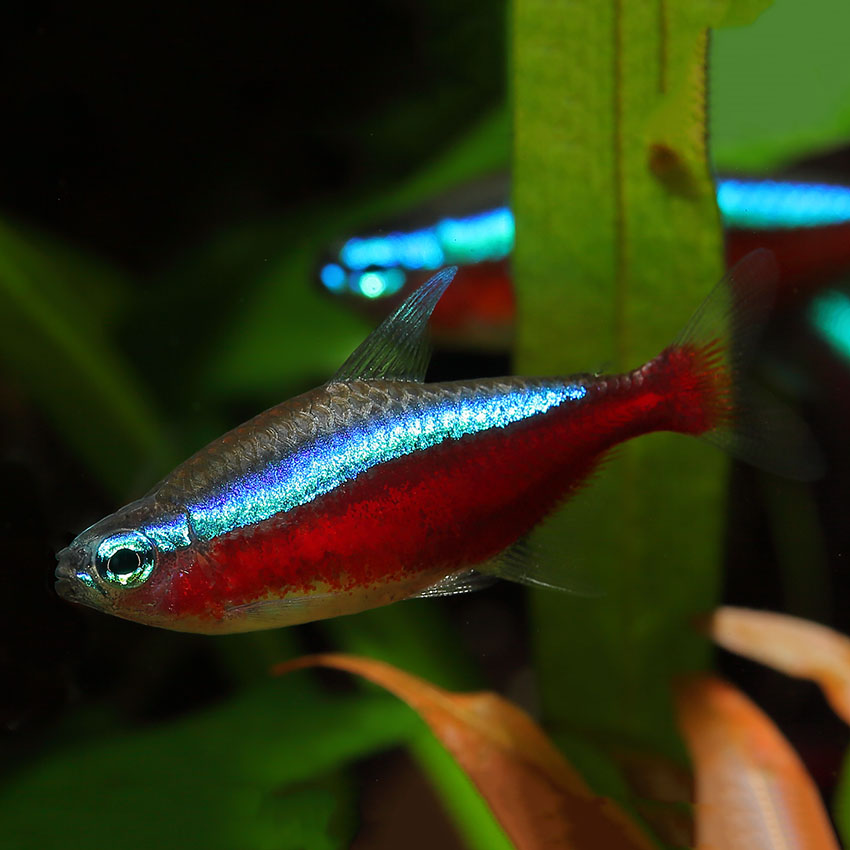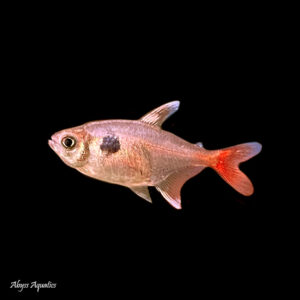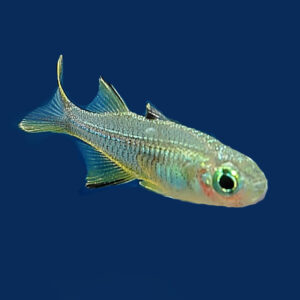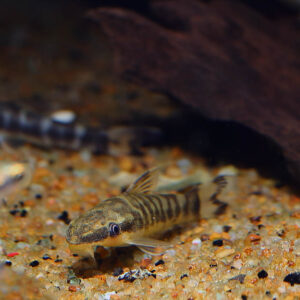Cardinal Tetra (Paracheirodon axelrodi) is a small freshwater fish known for its vibrant colors. They grow up to about 1.5 inches (3.8 cm) in length and have a distinctive blue and red stripe that runs down their body. The red stripe starts at the gills and runs to the base of the tail, while the blue stripe runs along the lower half of the body. This striking coloration makes them a popular choice for aquarists looking to add color to their tanks.
Our Cardinal Tetras are Tank Bred Here is why:
Abyss Aquatics only offers tank bred Cardinal Tetras because they are stronger and more resilient than cheaper wild-caught specimens. Wild-caught Cardinal Tetras are readily available, but they are often less healthy and more prone to disease than tank-bred fish. By sourcing commercial bred Cardinal Tetras, Abyss Aquatics can ensure that their fish are healthy, free from parasites, and accustomed to aquarium conditions. This reduces the risk of introducing diseases and parasites into a customer’s aquarium. In addition, tank-bred fish tend to be more adaptable to different water conditions, making them easier to care for and less likely to suffer from stress-related illnesses.
Furthermore, Abyss Aquatics is committed to sustainability and ethical practices in the aquarium trade. Wild-caught Cardinal Tetras are often harvested from sensitive ecosystems and can suffer high mortality rates during transport. By promoting tank-bred fish, Abyss Aquatics can help reduce pressure on wild populations and support responsible breeding practices.
Overall, offering tank-bred Cardinal Tetras aligns with Abyss Aquatics’ values of providing healthy, sustainable, and ethically-sourced fish to their customers.
What Does The Cardinal Tetra’s Natural Habitat Look like:
The natural habitat of Cardinal Tetras is the blackwater streams and tributaries of the Amazon River basin, primarily in Peru, Brazil, and Colombia. These streams have a slow to moderate flow, and the water is typically stained brown with tannins from the surrounding vegetation.
Cardinal Tetras inhabit the middle and lower layers of the water column, often schooling near the surface or among submerged vegetation. The water in their natural habitat is soft, acidic, and typically ranges in temperature between 75-82°F (24-28°C).
The substrate in their habitat is often made up of sand, leaf litter, and submerged roots, with a dense canopy of overhanging vegetation, such as low-hanging branches, roots, and aquatic plants, providing ample cover. The vegetation in their habitat plays a crucial role in maintaining the water quality and providing food and shelter for the Cardinal Tetras and other aquatic organisms.
Overall, the natural habitat of Cardinal Tetras is a tranquil, lush environment with slow-moving water, dense vegetation, and abundant biodiversity. It is an ecosystem that supports a diverse range of organisms, including fish, invertebrates, and other aquatic life.
Keeping Cardinal Tetra Healthy – Paracheirodon axelrodi:
Cardinal Tetras are fairly hardy fish, but they do require specific water conditions to thrive. They are sensitive to changes in water chemistry, temperature, and quality, so it’s essential to maintain a stable and clean environment. Regular water changes and a good filtration system are crucial to keeping these fish healthy. Cardinal Tetras prefer soft, slightly acidic water with a pH between 5.5 and 7.0. They also need a temperature range of 73-82°F (23-28°C) to stay healthy.
Tank maintenace
Maintaining a healthy aquarium environment is crucial for the well-being of your cardinal tetras. Here are some guidelines for aquarium maintenance:
- Water changes: Cardinal tetras are sensitive to water conditions, so regular partial water changes are necessary to maintain good water quality. It is recommended to change 10-20% of the water weekly.
- Filtration: A high-quality filtration system is essential to maintain good water quality. The filter should be cleaned regularly to prevent buildup of debris and waste.
- Gravel cleaning: Uneaten food, waste, and debris can accumulate in the gravel. Use a siphon to clean the gravel during water changes.
- Water testing: Regular testing of the water parameters (pH, ammonia, nitrite, nitrate) is necessary to ensure proper water conditions.
- Plant maintenance: If you have live plants in your aquarium, they will require pruning and maintenance to prevent them from overgrowing and taking over the tank.
- Temperature monitoring: Cardinal tetras are sensitive to temperature fluctuations, so it is important to monitor the temperature regularly and make adjustments as needed.
By following these guidelines and establishing a regular maintenance routine, you can create a healthy and thriving environment for your cardinal tetras.
Paracheirodon axelrodi Special Requirements and Feeding:
In addition to stable water conditions, Cardinal Tetras require a varied and balanced diet. They are omnivores and will eat a mix of live, frozen, and prepared foods. A high-quality flake or pellet food can form the basis of their diet, but it’s also essential to supplement this with live or frozen foods like brine shrimp, daphnia, or bloodworms. A varied diet ensures they get all the necessary nutrients for healthy growth and coloration.
How Many Cardinal Tetras (Paracheirodon axelrodi) Should I Keep:
The number of Cardinal Tetras you should buy depends on the size of your aquarium and your personal preferences. Cardinal Tetras are social fish that thrive in groups, and it is recommended to keep them in groups of at least 6 individuals, but a larger group of 10 or more individuals is even better.
In general, it is best to follow the rule of thumb of having at least one gallon – 4.5 litres of water per inch of fish, which means a group of 6 Cardinal Tetras would require a minimum of a 10-gallon (38-liter) aquarium. However, keeping a larger group of Cardinal Tetras may require a larger aquarium to provide adequate swimming space and maintain good water quality.
It is also important to note that Cardinal Tetras are relatively small fish, reaching a maximum size of around 1.5 inches (4 cm) in length, and they do not produce a large bioload, so they can be kept in a relatively small aquarium. However, it is important to provide adequate swimming space and hiding places to ensure their well-being.
Ultimately, the number of Cardinal Tetras you should buy depends on your aquarium size, water parameters, and personal preferences, but it is recommended to keep them in groups of at least 6 individuals to ensure their social and behavioral needs are met.
lighting Preference:
Cardinal Tetras (Paracheirodon axelrodi) prefer subdued lighting that mimics the dappled, low-light conditions of their natural habitat. In the wild, they are typically found in streams and tributaries with dense vegetation that filters out much of the sunlight, creating a subdued and diffused light environment.
When kept in an aquarium, Cardinal Tetras should be provided with low to moderate lighting that is not too bright or intense. A lighting period of 8-10 hours a day is ideal for Cardinal Tetras, and the lighting should be gradually increased or decreased to simulate the natural light cycle.
It is also important to note that excessive lighting can lead to algae growth, which can be harmful to the health of the Cardinal Tetras and other aquarium inhabitants. To prevent algae growth, it is recommended to keep the aquarium away from direct sunlight and to use a high-quality aquarium light that provides low to moderate lighting levels.
Overall, Cardinal Tetras prefer subdued lighting that replicates the natural light conditions of their habitat. A low to moderate lighting period of 8-10 hours per day is ideal for these fish and can help promote their health and well-being in the aquarium.
Suitable Tank Mates:
Cardinal Tetras are peaceful fish and make great community tank mates. They do best in groups of at least six, and it’s essential to provide them with plenty of hiding places to reduce stress. Good tank mates for Cardinal Tetras include other small, peaceful fish like Neon Tetras, Harlequin Rasboras, and Dwarf Corydoras. Avoid keeping them with larger, more aggressive species that may see them as food.
Suitable Aquarium Plants for Cardinals:
Cardinal tetras are known to appreciate a heavily planted aquarium. Live plants not only provide a natural environment but also help to maintain good water quality and oxygenate the water. Here are some suitable aquarium plants for cardinal tetras:
- Java Moss (Taxiphyllum barbieri): Java moss is a hardy and versatile plant that can be attached to driftwood, rocks, or left floating in the water. It provides hiding places for fry and shrimp and is a great breeding ground for infusoria, a microscopic food that young fish can feed on.
- Amazon Sword (Echinodorus bleheri): Amazon swords are popular and easy to care for aquatic plants. They provide shelter for fish and are known for their long, green leaves.
- Java Fern (Microsorum pteropus): Java fern is a slow-growing plant that can be attached to driftwood or rocks. It provides hiding places for fish and can also be used to create a natural-looking aquascape.
- Anubias (Anubias barteri): Anubias are another slow-growing plant that can be attached to rocks or driftwood. They have broad, dark green leaves that provide cover for fish and are low maintenance.
- Water Wisteria (Hygrophila difformis): Water wisteria is a fast-growing plant that can be used as a background plant or left to float on the surface. It provides oxygenation and helps to remove excess nutrients from the water.
- Cryptocoryne (Cryptocoryne wendtii): Cryptocoryne is a low-growing plant that can be used to create a foreground in your aquarium. It has broad, green leaves that provide cover for fish and adds a natural touch to the aquascape.
These are just a few of the many suitable aquarium plants for cardinal tetras. When choosing plants, it is important to consider the lighting and water conditions in your aquarium to ensure that the plants can thrive.
Lifespan:
Cardinal Tetras have a lifespan of 3-5 years in captivity if their needs are properly met.
Breeding Cardinal Tetra – Paracheirodon axelrodi:
Breeding Cardinal Tetras can be challenging, but with the right conditions and proper care, it can be a rewarding experience. Here are some detailed breeding tips for Cardinal Tetras:
- Create the Right Conditions: Cardinal Tetras prefer soft, slightly acidic water with a pH between 5.0 and 6.5 and a temperature between 78-82°F (26-28°C). A separate breeding tank should be set up with a sponge filter, a heater, and subdued lighting. The water should be kept clean, and the breeding tank should be heavily planted with fine-leaved plants such as Java moss or spawning mops.
- Conditioning the Breeding Pair: Choose healthy, adult Cardinal Tetras that are at least 2 years old and condition them with a high-quality diet, including live and frozen foods, such as daphnia, mosquito larvae, and brine shrimp, for at least two weeks before breeding.
- Spawning: Once the breeding pair has been conditioned, they can be introduced into the breeding tank. The temperature should be raised to around 80°F (27°C), and the lighting should be kept subdued. The female will lay 100-300 eggs on the leaves of the plants or on the spawning mop. After spawning, remove the breeding pair to prevent them from eating the eggs.
- Hatching: The eggs will hatch in 24-36 hours, and the fry will be free-swimming after 3-5 days. The fry should be fed infusoria, small live foods, or commercially available fry food for the first week. Gradually introduce baby brine shrimp or microworms as they grow.
- Rearing the Fry: It is essential to maintain clean water and a stable environment for the fry. Regular water changes of 25-50% should be done, and the filter should be carefully cleaned to prevent any damage to the fry. After 2-3 weeks, the fry should be big enough to accept commercially available flake food.
Breeding Cardinal Tetras can be a delicate process, and patience and attention to detail are crucial. With the right conditions and proper care, breeding Cardinal Tetras can be a rewarding experience for fish keepers.
Distribution:
Cardinal Tetras are native to the Amazon Basin in South America, where they live in slow-moving streams and tributaries. Wild caught specimens are widely available, but at Abyss Aquatics, we offer stronger, more resilient tank-bred Cardinal Tetras. Our fish are bred in optimal conditions, ensuring they are healthier and more resistant to disease than cheaper wild-caught specimens.
Summary:
In summary, Cardinal Tetras (Paracheirodon axelrodi) are a popular and colorful addition to any aquarium. They require stable water conditions, a varied diet, and suitable tank mates to thrive. While they can be challenging to breed, their striking colors and peaceful temperament make them a favorite among aquarists. At Abyss Aquatics, we offer tank-bred Cardinal Tetras that are stronger and more resistant than cheaper wild-caught specimens.





Denise parr (verified owner) –
I ordered these fish in November, I had up graded to a 65l tank, I lost some of the fish as the tank came with a cat fish, now renamed. Came well packaged . I have ordered some more for my new 200l tank , they are pretty to watch when they are in a big group, thank you abyss
Janet Evans –
5* + Great service/packaging/delivery/advice and most importantly very good sized and hardy Cardinal Tetras. Will use again
Aram Rahaman –
The fish i recieved from the Abyss were stunning fish! Acclimitised perfectly and are now the stand out fish in my tank, looking even better than the cardinal tetras i already had in my tank which are twice the size. Will definitely be shopping with Abyss again
Chloe Okeeffe (verified owner) –
Awww these are so cute and bright and probably my favourite fish in my tank… might have to order some more